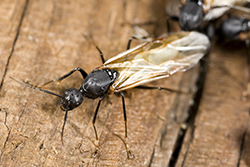Carpenter Ant Cycle: Identifying Carpenter Ants
 Before we begin to describe the carpenter ant cycle, it’s important to identify carpenter ants. They can look like other ant species, which behave differently, cause different problems, and need to be eliminated by other methods.
Before we begin to describe the carpenter ant cycle, it’s important to identify carpenter ants. They can look like other ant species, which behave differently, cause different problems, and need to be eliminated by other methods.
Carpenter ants vary in size and color. At their smallest, they can even be confused with the tiny pavement ant. One way to identify carpenter ants is by the piles of sawdust they create as they shave off small bits of wood and carry them out of their nest. However these piles may be hidden inside of walls, so you could have a carpenter ant problem and not know it.
Image: Credits: Identifying and Controlling Carpenter Ants – Modern Pest
Carpenter Ant Cycle: Nesting In Wood
Unlike termites, carpenter ants don’t eat wood. They excavate channels in wood for their growing colonies. While they do not cause the structural damage of termites, they can still be destructive. Part of the problem is the the wood they prefer is damp or rotten due to a water leak. They then excavate channels into this damp wood, weakening it further.
 Carpenter Ant Cycle: Creating Satellite Nests In Wood
Carpenter Ant Cycle: Creating Satellite Nests In Wood
How widespread is the damage? A single carpenter ant colony is comprised of many satellite nests. There are usually many satellite nests around the main nest. That main nest, for example, could be located in a rotten tree stump in or near your yard, with satellite nests in your home!
Image: Credits: Identifying and Controlling Carpenter Ants – Modern Pest
Carpenter Ant Cycle: Each Successive Brood Produces Larger Ants
Interestingly enough, the first ants produced by a queen are small in size (about 1/4 inch). This is where they are sometimes mistaken as pavement ants. Following broods by the same queen become larger–up to twice that size. As they forage, they are likely to enter your home.
 Carpenter Ant Cycle: Swarmers and Reproduction
Carpenter Ant Cycle: Swarmers and Reproduction
Later, as the nest matures, swarmers appear. Most swarmers appear in the spring, but can emerge throughout the summer. The female swarmers are easy to identify. They’re up to 4 times the length of the first brood of ants–as much as an inch long, and they have brown translucent wings. The males are about 1/2 inch and also have wings. After mating, the female will drop her wings and start a new carpenter ant colony.
Image: Credits: Identifying and Controlling Carpenter Ants – Modern Pest
Carpenter Ant Cycle: Ending the Cycle
To end the cycle, every nest and satellite nest both inside and near the home will need to be located and eliminated. It’s a real detective case and the hunt is most successfully carried out by a professional pest exterminator who can easily spot even the most subtle signs of a carpenter ant nest of satellite nest.
In addition, since carpenter ants are so persistent, it can take multiple routine visits by the professional to thoroughly eradicate the ant nests and satellite nests in and around your home.
Call ApolloX Pest Control
(888) 499-7378
We’re the carpenter ant professionals!














Recent Comments